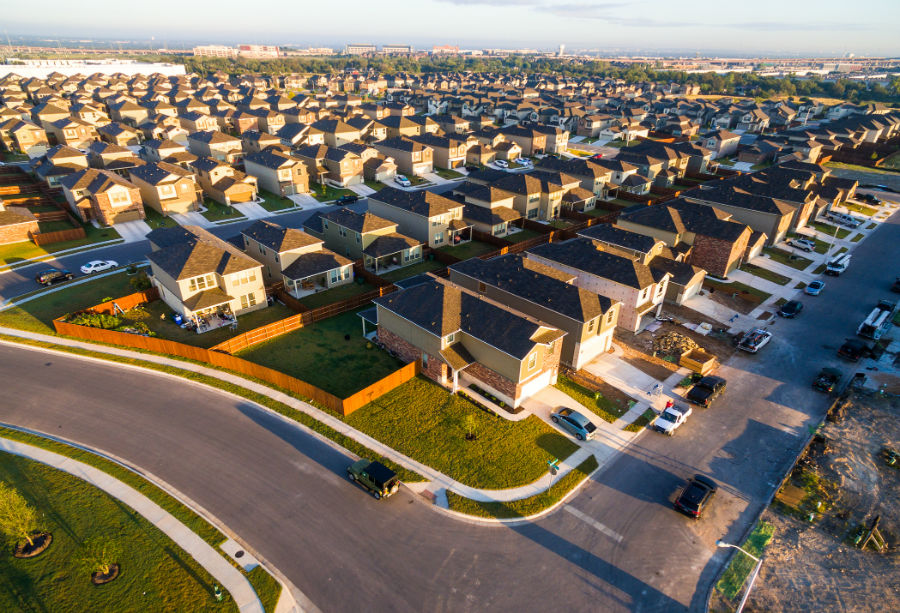Tuesday, January 3rd, 2017 and is filed under Construction, Economy, General, Housing Affordability, Housing Market, Housing Starts

MORE 2017 PREDICTIONS
Two recent articles written focused on what’s likely to happen in Texas housing in 2017. Now it’s time to take a broader view, and see some other housing trends to keep an eye on in the coming year1.
Looking to the Sky
Mention “drones” and what might come to mind are surveillance and the NSA. But the unmanned aerial vehicles (UAVs) are elbowing their way into commercial usage. And thanks to the Federal Aviation Administration (FAA), just about anyone in the United States can find a drone, so long as the aircraft meet a certain set of requirements.
The residential real estate industry is already dipping its collective toe in the drone waters. Realtors and real-estate agents are using the UAVs for property flyovers. In the coming year, home-sellers, and even home-buyers will be using them.
Why would a home-buyer need a drone? “Buyers in Seattle are skipping the home inspection because the market is so hot,” said Steve McIrvin, who is with drone manufacturer Autel Robotics USA2. McIrvin added that the buyers can, instead, send in the drone for a quick look at a potential property, and be able to examine the condition of the roof, the land around the house, and other exterior factors.
Changes to Suburbia
The 1980s and 1990s suburban sprawl, made up of McMansion style homes and strip malls, is fast giving way to mixed-use communities, complete with town houses, apartments and single-family homes in the same neighborhoods, and amenities. This trend means people can live, work and play on the same general area. Welcome to the the new suburbia, in which residents can walk to work, to the local entertainment, and to the grocery store.
The new suburbia is designed to be inclusive – so rather than consisting mainly of large, residential houses, an hour-long commute to the office, and a 15-minute drive to the nearest shopping center, these newer developments make it more convenient to get around. It also means housing is somewhat more affordable in these suburbs.
According to John Burns Real Estate Consulting’s Danielle Leach, today’s suburban living is a blend of both urban and suburban components, complete with nearby shopping, entertainment, parks – and a strong public school system3.
Millennials in the Mix
Many of our 2016 blogs focused on millennials and home-buying. Those topics covered everything from lack of starter homes for the group, to an inability to save up enough down payment for a home.
But the National Association of Realtors (NAR) also pointed out that millennials are readying to jump into the home-buying market – another topic we addressed. In 2016, the NAR noted that 17% of buyers under the age of 35 could save up enough to place a down payment on a house within a year, compared to 14% of all age groups. Delving down even further, 37% of buyers under the age of 35 indicated they could save up enough for a down payment within six months, compared to 46% of all other buyers.
Having said that, student debt is still considered one of the top factors that will influence home-buying among the millennial group. The NAR pointed out that 44% of this age group has a student-loan debt balance of at least $25,000.
The Up-and-Coming Generation Z
The Gen Z age group – also known as Post-Millennials, iGeneration, Founders, Plurals or the Homeland Generation – were born starting around 1997-1999 and through the 2000s. With this definition in mind, the eldest Generation Z-ers will turn 20 in 2017. Though 20 isn’t necessarily a home-buying age, it does pay to remember that Generation Z young adults are coming of age with less skepticism toward homeownership than their older millennial counterparts.
Members of Generation Z didn’t experience the crippling recession, war, terrorism and stock-market collapse that their older brothers and sisters did. Rather, Generation Z’s experiences are running to the low interest rates, higher wages and strong job prospects.
This age group is also more about home ownership. According to the NAR, 97% of Gen Z participants surveyed want a home. A large home.
[1] Daniel Goldstein (Dec. 4, 2016). “5 Big Real Estate Trends to Watch in 2017.” MarketWatch. Retrieved from http://www.marketwatch.com/story/5-real-estate-trends-to-watch-in-2017-2016-11-15
[2] Ibid.
[3] Ibid.